Hoofdstuk 2
Over uitdrukkingen in houding en gezicht: onderzoek naar emoties met Harry von Piekartz, `La Statuaire Mobilé en Archetypen, het ‘Body Action System’. ‘BEAST’ en ‘Why bother about bodies?’
Het accent van het onderzoek komt steeds meer te liggen op de uitdrukkingen van het lichaam in houding en motoriek: van uitdrukkingen in het gezicht naar uitdrukkingen in het lichaam. Werken de uitdrukkingen in het lichaam volgens de zelfde universele herkenningspunten? Hoe werkt het? Met proefnemingen komt er een helder beeld naar voren hoe elke uitdrukking van emotie een eigen opbouw in beweging en houding heeft. In de ‘Dans van emoties’ is dit verder uitgewerkt.
Harry von Piekartz, onderzoek naar basis emoties in gezicht en lichaam:
In 2015 werden het onderzoek en de emotiemaskers gepresenteerd en direct daarna is er een uitnodiging van dr. Harry von Piekartz, University of Applied science, Physiotherapy in Osnabrück. In 2017 start een gezamenlijk onderzoek, gericht op gezicht- en houding uitdrukkingen tijdens emoties.
Bij dit onderzoek gaan we uit van:
- De relatie tussen basisemoties in het gezicht en in het lichaam.
- Het gedrag van de wervelkolom tijdens verschillende uitdrukkingen van basis emoties en pijn.
- De invloed van pijn in gezichts- en lichaamsexpressie, zowel bij gezonde proefpersonen als voor zover na te gaan bij chronische pijn toestanden.
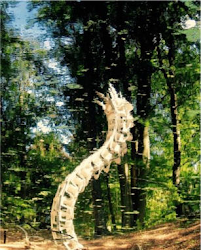
Spiegelbeeld in het water: Installatie beeld‘Ruggengraat’ tijdens optredens met ‘Spine Conversations’van Sjoerd Schwibettus, part of performance ‘Spine conversations' theaterfestival Vuurol 2018. Photo by Jaap Berends. Rechter afbeelding: My face, training site voor emoties.
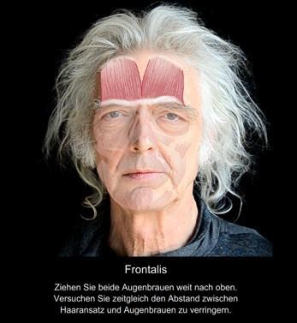 We gebruiken bij ons onderzoek visuele analyse, dat wil zeggen dat we met de mime techniek van Decroux de lichaamsuitdrukking in zijn geheel in patronen en in lichaamsdelen onderscheiden. De mime techniek van Decroux geeft een heldere onderscheiding van alle lichaamsdelen die afzonderlijk of in opbouw een actie ondernemen. Deze mime techniek wordt apart in hoofdstuk 4 uitgelegd. Het gezamenlijk onderzoek met dr. Harry von Piekartz resulteert in verschillende films waarin de resultaten naar voren komen.
We gebruiken bij ons onderzoek visuele analyse, dat wil zeggen dat we met de mime techniek van Decroux de lichaamsuitdrukking in zijn geheel in patronen en in lichaamsdelen onderscheiden. De mime techniek van Decroux geeft een heldere onderscheiding van alle lichaamsdelen die afzonderlijk of in opbouw een actie ondernemen. Deze mime techniek wordt apart in hoofdstuk 4 uitgelegd. Het gezamenlijk onderzoek met dr. Harry von Piekartz resulteert in verschillende films waarin de resultaten naar voren komen.
In ‘Facial & Posture Expressions of Basic Emotions’ (gezicht en houding uitdrukkingen van basisemoties) vragen we ons af: * Is er invloed van gezichts basis emoties op lichaamsexpressie? En andersom? • Wat zijn natuurlijke patronen van de wervelkolom tijdens basisemoties? en wat zien we bij chronische musculoskeletale pijn?
We onderzoeken bij gezonde proefpersonen en bij personen met chronische pijn toestanden.• De relatie tussen gezichtsbasis emoties en lichaamsexpressie in diepte van expressie
• Het gedrag van de wervelkolom tijdens verschillende basisemotie-expressies en pijn
• De invloed van pijn in gezichts- en lichaamsexpressie
We meten door:
• observatie - visuele analyse
• analyse van de beweging geschiedt op basis van de techniek van mime corporel
• Gezichtsanalyses wordt in spiergroepen benoemd.
 Voorbeelden van houding en ruggengraat – basis emoties in houding in ‘stickfigures’
Voorbeelden van houding en ruggengraat – basis emoties in houding in ‘stickfigures’
kwaad, angstig, verdrietig. De live opnamen werden via Qualisys en software omgezet.
De invloed van emoties op uitdrukkingen in het gezicht en in het lichaam is duidelijk. Gezicht, lichaam en stem zijn aanvullend en hebben een autonome manier van communicatie. Het lichaam heeft een eigen lichaamstaal en de natuurlijke patronen van de wervelkolom tijdens basisemoties en bij chronische musculoskeletale pijn leren ons de uitdrukkingen te begrijpen voor revalidatie wanneer deze geblokkeerd zijn of niet (goed) functioneren.
Film Facial & Posture Expressions
 https://youtu.be/aJ38iSYpP8A (QR *met nummer)
https://youtu.be/aJ38iSYpP8A (QR *met nummer)
In de film zijn talrijke voorbeelden van proefpersonen te zien – acteurs in september 2017 op de Universiteit voor de Kunsten in Arnhem. Er worden opnamen gemaakt van uitdrukkingen in gezicht en houding van basis emoties.
In het 2e deel van de reportage zien we een aantal acteurs in het Motion Lab te Osnabrück van de Universiteit Applied Sciences.
Door middel van motion Qualises system wordt hier met verschillende camera’s rondom de acteurs opnamen van de beweging gemaakt. Er zijn reflectie kogels aangebracht op de ruggengraat zodat de beweging daar precies geregistreerd en omgezet kan worden naar skelet figuren-'stick figures', waardoor de beweging en houding van ruggengraat duidelijker onderscheiden kan worden.
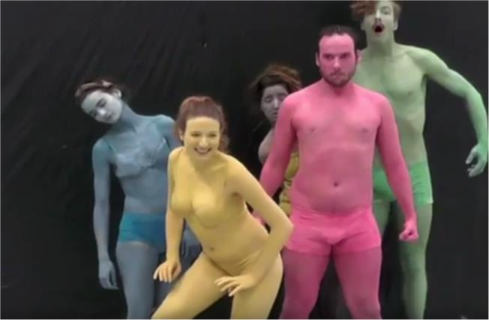 In Emotion & Color laat het 1e filmpje een maakproces van 3-4 minuten van acteurs zien die 1 emotie in verschillende gradaties verbeelden en met het hele lijf in een – volgens ons passende kleur geschminkt.Het gaat om 6 basis emoties en pijn, omdat pijn vaak in relatie met emoties wordt ervaren en wordt geassocieerd. Zijn de kleuren die gekozen zijn passend bij de verbeelde emotie?
In Emotion & Color laat het 1e filmpje een maakproces van 3-4 minuten van acteurs zien die 1 emotie in verschillende gradaties verbeelden en met het hele lijf in een – volgens ons passende kleur geschminkt.Het gaat om 6 basis emoties en pijn, omdat pijn vaak in relatie met emoties wordt ervaren en wordt geassocieerd. Zijn de kleuren die gekozen zijn passend bij de verbeelde emotie?
Blij = geel, angst = grijs, walging = bruin, pijn = rood/paars, verwondering = groen, verdriet = blauw, kwaad = roze/rood
Kleur helpt bij herkenning, bij rehabilitatie en bij training van emoties.
.
Film Emotion & Color – maakproces en de resultaten

 https://youtu.be/rlW6aXaFgQwhttps://youtu.be/osOhljn4J44(QR*nrs)
https://youtu.be/rlW6aXaFgQwhttps://youtu.be/osOhljn4J44(QR*nrs)
Emotie en Kleur, de resultaten: Het filmverslag van de resultaten Emotion & Color, toont de uitdrukkingen van alle 6 basisemoties en pijn, en laat dit heen en weer in kleine en grote vorm zien:
Blij, open en vrij, neemt in volume toe in de ruimte en straalt - symmetrisch in beweging,
Kwaad = rood roze: agressief, komt naar voren in de ruimte - scherp asymmetrisch in beweging
Verdrietig = blauw: humeurig, koud, klein, afstandelijk en neemt afstand in ruimte naar beneden en naar achter - zacht asymmetrisch in beweging
Verbaasd = groen: open ogen, verwonderd - op dezelfde plek toenemen in volume, zacht asymmetrisch.
In pijn = paars rood: klein-bescheiden, zal niet aandringen, komt naar voren in beweging, scherp asymmetrisch.
Walging = bruin: walging, afkeer, afwijzing – neemt afstand in ruimte naar achteren, toenemend scherp asymmetrisch
Bang = grijs: angst, ongemak, bevroren en vastgehouden spanning, neemt afstand naar achteren in ruimte – zacht asymmetrisch in beweging.
Tussen de series van de emotie uitdrukkingen door zijn korte opnames gemonteerd van acties uit de compositie ‘Ruggengraat Conversaties’ welke werd uitgevoerd in samenwerking met Orkest De Ereprijs. De gekleurde acteurs laten continue ‘gesprekjes’ zien van de ruggengraat houdingen ten opzichte van elkaar. De houding van de ruggengraat zien we ook sterk gebruikt in de archetypen van de Commedia dell’Arte. (zie de film ‘The sculpture of man in motion’=QR*nr)
Er zijn patronen zichtbaar in lichaamstaal, we letten op kenmerken in beweging bij elke verbeelde emotie en we kijken of deze symmetrisch worden uitgedrukt of zijn losgekoppeld. Ook is er direct een correlatie tussen ruimtegebruik zodra de emotie in beweging wordt omgezet en is er een tendens en nadruk bij elke emotie in tijdsduur.
Later zijn deze patronen verder verwerkt in morph filmtechnologie en zijn de bewegingen als stick figures gevisualiseerd door middel van het Qualisys motion capture-systeem. Er worden daarvoor reflectie kogels op verschillende scharnierpunten en ruggengraat geplaatst en de actie wordt met surround camera’s in de ruimte in 3 d vastgelegd. Door middel van een softwareprogramma worden de bewegingen van de acteur nu omgezet in skelet-stok figuren waardoor de beweging nauwkeuriger onderscheiden kan worden. Zie daarvoor ook de ‘Dans van Emoties’, waar in een totaalbeeld 4 acteurs de 6 basis emoties in lichaamsuitdrukking laten zien en waardoor verloop, tijdsduur en ruimtegebruik zichtbaar wordt.
Link: Film The sculpture of man in motion met ‘Spine Conversations’
 https://youtu.be/9A4A77dVr3A(QR*nr)
https://youtu.be/9A4A77dVr3A(QR*nr)
‘Spine Conversations’ werd voor het eerst gepresenteerd op Vuurol mei 2018 en in Theater De Plaats Arnhem met orkest De Ereprijs februari 2018.
Hoe spreek je met je ruggengraat? De voortdurende beweging verandert van kleur en uitdrukking. De dynamiek van de voortdurende beweging is van invloed: we nemen de dynamiek van de vorming waar om zo elkaars gedachten en intenties te lezen. In de documentaire film ‘’The Sculpture of man in motion’ zien we op verschillende locaties de acteurs en musici repeteren en optreden met een installatie die de ruggengraat verbeeldt.
La Statuaire Mobilé: Gezichtexpressie en lichaamstaal vullen elkaar aan. Er is een duidelijke relatie tussen lichaamsuitdrukking en gezichtsuitdrukking. Expressie en perceptie van lichaam en gezicht zijn beide een dynamisch proces.
Lichaamsuitdrukkingen van emotie omvatten beweging van alle lichaamsdelen en houding.
Bekeken vanuit de Kunsten in Theater en Dans, is de wervelkolom het belangrijkste centrum omdat alle bewegingen en uitdrukkingen in de romp zitten. Voor wat betreft de lichaamstaal is het gewicht in zijn dynamische gebruik al op zichzelf de uitdrukking: een verplaatsing van gewicht is niet alleen functioneel!
Zonder te lopen kunnen we door gewicht te verplaatsen in andere houdingen veel uitdrukking met het lichaam genereren: we kunnen met ons gewicht naar voren, naar achteren en opzij, naar beneden en naar boven en we kunnen draaien. Dat wil zeggen dat we met buigen (kantelen) en draaien het lichaam geheel of deels met hoofd, hals, borstkas, middel, bekken, ons gewicht verplaatsen en daarmee een specifieke houding aannemen.

La statuaire mobilé en Archetypen:
La statuaire mobilé (Corporeal Mime Decroux) is een belangrijk concept vanuit de Mime corporel en legt uit hoe we de uitdrukking en de archetypische houding en connotatie ervan kunnen definiëren en begrijpen. De sculptuur van de mens in beweging is daar het uitgangspunt. Stop – motion: beweging kan niet zonder stilstand (zoals muziek ook niet kan bestaan zonder stilte). Het principe van het ‘bewegend standbeeld’(= La statuaire mobile) is nadrukkelijk aanwezig om zo de uitdrukking in houding te kunnen onderscheiden. Het ‘bewegende standbeeld’ is erg populair geworden in de grote steden en theaterfestivals. Arnhem was jarenlang de stad van het festival Living Statues.
Het onbeweeglijk stilstaan, de acteur of actrice is vaak als standbeeld in marmer of in brons gekleed en geschminkt en komt als de argeloze bezoeker langs loopt, vanuit de standbeeld stilstand plots even in beweging.
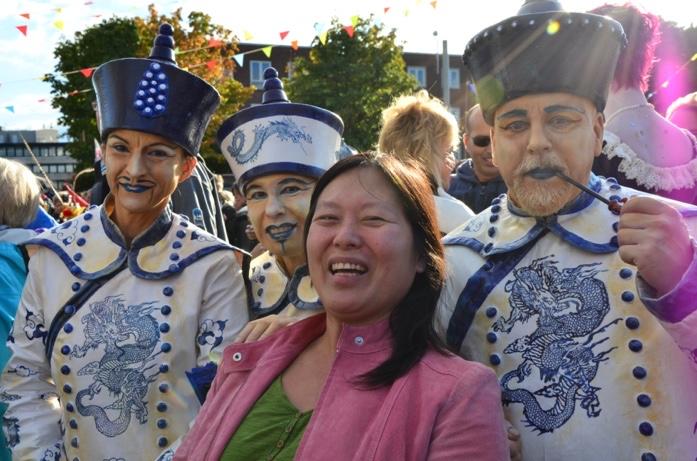 |
"Living statues” – festival Arnhem 2009 |
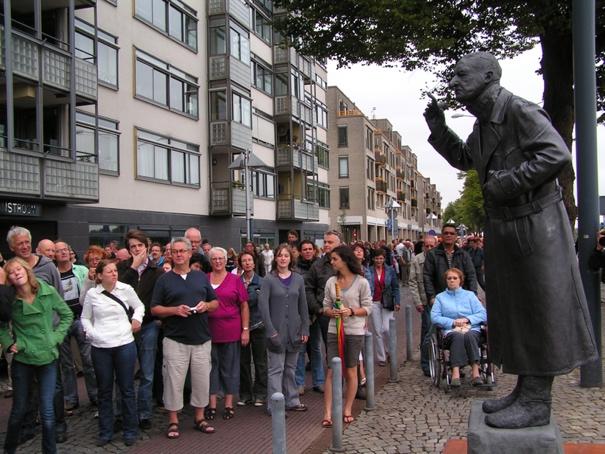 |
"Living statues” – festival Arnhem 2009 |
De term "archetype" vindt zijn oorsprong in het Oudgrieks. De basiswoorden zijn archein, wat "oorspronkelijk of oud" betekent; en typos, wat "patroon, model of type" betekent. De gecombineerde betekenis is een "oorspronkelijk patroon" waarvan alle andere soortgelijke personen, objecten of concepten zijn afgeleid, gekopieerd, gemodelleerd of geëmuleerd. De psycholoog Carl Gustav Jung gebruikte het concept van archetype in zijn theorie over de menselijke psyche. Hij geloofde dat universele, mythische karakters—archetypen—zich bevinden in het collectieve onderbewustzijn van mensen over de hele wereld. Archetypen vertegenwoordigen fundamentele menselijke motieven van onze ervaring terwijl we evolueerden; bijgevolg roepen ze diepe emoties op. In Commedia dell’Arte bestaat het archetypische uit ten minste 9 keer individuele gelijke semantiek, tokens of gebaren. De meeste, zo niet alle mensen hebben verschillende archetypen in hun persoonlijkheidsconstructie; echter, één archetype heeft de neiging om de persoonlijkheid in het algemeen te domineren. De personages in maskers, Commedia dell’Arte-personages en de sculpturen van de mens in beweging werken hetzelfde: het archetypische van de expressie is afgeleid van overeenkomsten tussen ten minste 9 individuele eigenschappen van dezelfde groep.
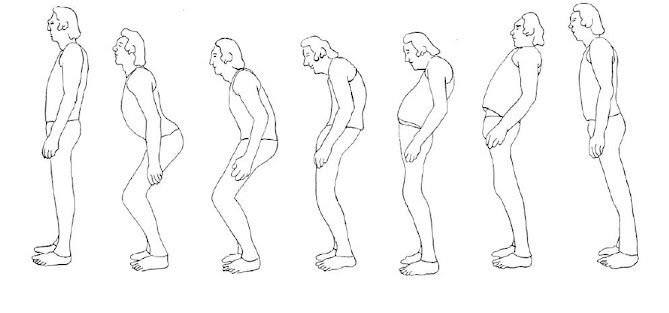 |
| De golfbeweging: Pulcinella, Arlecchino, Pantalone, Il Dottore, Capitano, Hulot:
telkens is er 1 lichaamsdeel geaccentueerd op de voorgrond in de spanning
van de ruggengraat. De golfbeweging als geheel stopt onderweg en
houdt daar de spanning-geladenheid van de houding vast en
vormt zo in houding en spanning het archetypische karakter van
de Commedia dell’arte. (tekening Emmy Chau) |
Innerlijk: Wat zit van binnen? Een expressie is het duidelijkst wanneer de beweging vanuit het centrum en van binnenuit wordt uitgevoerd.
Het gaat om het onderscheid en het om de expressiewaarde.
Als de onderrug en de ‘core’ niet met spanning en spieren worden ondersteund, zullen de meeste mensen compenseren door hun borst en hoge schouders op te trekken, en de expressie wordt daarom beperkt of tegengehouden. Als de voeten en benen niet strekken of stijf zijn en ver onder hun capaciteit werken en een beetje doorgezakt lijken, geven ze de betrokken lage energie en spierspanning door aan de wervelkolom en houding. De borst doet dan zijn best om dit alles te compenseren door extra kracht te zetten en zal bijvoorbeeld minder ontspanning of tederheid kunnen uitdrukken. De innerlijke vorm moet worden begrepen als energie en bevat in zijn aanwezigheid architectonische elementen van wat het communiceert. Deze innerlijke vorm is gekoppeld aan het gewicht dragen en tegengewicht inzetten.
Kracht, snelheid, impuls, ademhaling, spierspanning, ontspanning en weerstand:
Ons lichaam kan worden beschouwd als een keten en bouwsel van botten, spieren en gewrichten en fascia. In ons dagelijks functioneren bewegen we in deze kinetische ketens. Het lichaam is het instrument en de innerlijke vorm reflecteert in zijn expressiviteit
‘Body Action Coding System’:
Gebruikt het lichaam dezelfde impuls van de emoties om een emotie uitdrukking te vormen? Sinds het laatste decennium groeit het besef dat dit het geval is. Sinds kort is men in de wetenschap begonnen met het ontwikkelen van een zogenaamd ‘Body Action Posture Coding System’ (BACS) en sommige studies onthullen al met EMG (elektromyografie) de directe relatie tussen lichaam contracties en emotie-uitdrukkingen.
De BACS is het eerste coderingssysteem gebaseerd op spieractiviteit. Er is ook een toenemende focus op de ontwikkeling van systemen die in staat zijn om emotionele lichaamstaal te creëren of te herkennen voor de ontwikkeling van avatars en virtuele beeldvorming. Daartoe worden meerdere coderingssystemen ontwikkeld om lichaamsuitdrukkingen te interpreteren of te creëren, hetzij in statische houdingen of met beweging. Veel onderzoek naar emotie van lichaam en gezichtsuitdrukkingen maakt gebruik van het afbeelden van uitdrukkingen in statische posities of met beweging om patronen te detecteren. Systemen zoals in ‘facetagging’ of met Qualisys (capture motion system) genereren en verwerken de gegevens die worden gebruikt voor herkenning.
Proef met masker van stof: In studies namen we een stuk stof om het gezicht te bedekken (net als Decroux deed bij zijn presentaties van Mime corporel) en de acteur toonde een bepaalde uitdrukking van emotie in houding met zijn hele lichaam (geen stem maar met hoorbare ademhaling). De groep studenten die betrokken waren, kende de gegeven uitdrukking niet van tevoren.
Met meer dan 90% nauwkeurigheid werd de gegeven uitdrukking van emotie gedefinieerd. Meestal was de ruggengraat de kern voor observaties. De neiging is natuurlijk om aan de veilige kant te blijven en te zoeken naar meer details in stereotype gebaren of dergelijke. Wanneer dit wordt geëlimineerd, is de observatie het meest helder. De houding impliceert meestal een strategie van acties die worden gegeven in onderliggende intentie en (a)symmetrische houding. Dat betekent dat we vanzelfsprekend de dynamiek interpreteren aan de hand van een gegeven stilstaande houding.
Statische houding is een momentopname van een geheel: Als een statische houding wordt verwerkt als een strategie in de hersenen, is niet alleen de houding als een kader of vorm-contour belangrijk, we leiden de mogelijke intentie af van de gegeven houding en de spanning.
Om de strategie te begrijpen staat bij elke uitdrukking op het spel: is er een reden om bang te zijn, moet ik boosheid tonen, is het beter om walging te tonen enz.
Opmerkelijk is hier opnieuw de parallel tussen Wetenschap en Kunst:
In dit onderzoek is het concept van houding een leitmotiv. De ‘sculptuur van de mens in beweging’ is hetzelfde als het principe achter ‘Statuaire Mobilé' van de Mime corporel van Etienne Decroux.
Ik noem hierbij ook de ‘Actor of wood’ en 'Uber Marionette', 2 begrippen uit de discussie tussen theater vernieuwers Decroux en Edward Gordon Craig die zich beide de vraag stelden of de ideale acteur c.q. mimespeler nu een ‘acteur van hout’ (robot) moet zijn of een 'super marionet' ('Uber Marionette'). In beide gevallen is de ziel van de acteur niet duidelijk aanwezig in zijn spanning en menselijke overdracht.
De ideale mimespeler paart natuurlijk intentie met perfecte articulatie. En dat betekent dat de ruggengraat het klavier is van het lichaam: je moet als fysieke acteur, mimespeler de perfectie nastreven en de uitdrukking en beweging articuleren om zo expressiever te kunnen zijn voor wat je wilt uitdrukken met je lichaam. En daarbij kun je de ruggengraat in al zijn mogelijke bewegingen inderdaad als het klavier van het lichaam beschouwen.
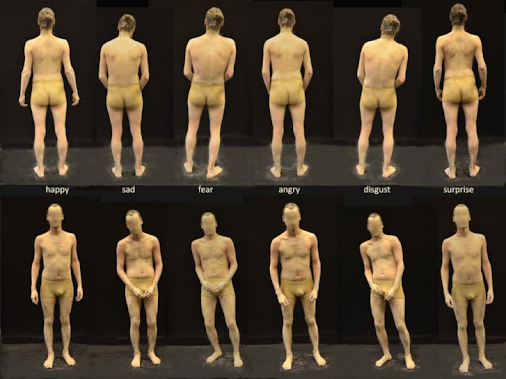
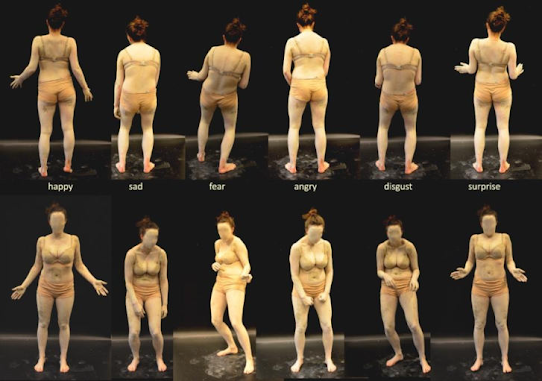
6 basisemoties in uitdrukking van het lichaam: In deze 2 afbeeldingen zijn alle 6 basisemoties door acteurs verbeeld in uitdrukking van het lichaam. Het hoofd is expres vervaagd zodat de aandacht geheel op de uitdrukking van het lichaam ligt. Bij observaties zien we de voorwaartse en opwaartse neiging van het lichaam bij blijheid. Andersom is een achterwaartse en naar beneden gerichte neiging te zien bij verdrietig. Evenzo is dit het geval bij bang en bij walging. We zien een zeer besliste neiging naar voren gaan bij kwaad. Verwondering lijkt in lichaamstaal in zijn ruimtegebruik voor een deel op blij. Bang, walging en kwaad zijn het sterkst in asymmetrische beweging.
Samengestelde uitdrukkingen van emotie
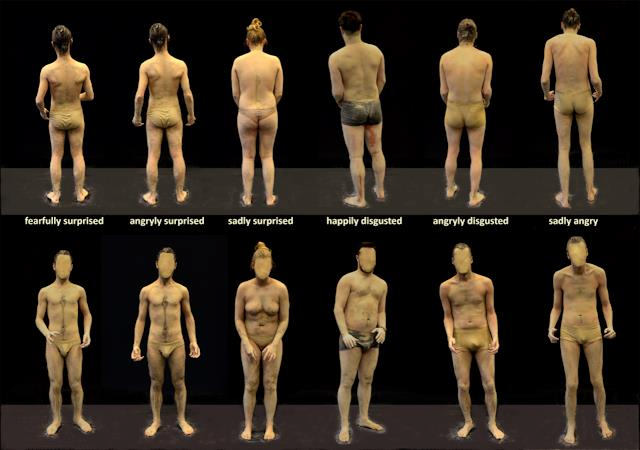 |
| 6 samengestelde lichaamsuitdrukkingen van emotie – Onderzoek 2021 |
Bang verbaasd, kwaad verbaasd, verdrietig verbaasd, blij verbaasd, kwaad walgend en verdrietig kwaad zijn hier door acteurs verbeeld in de uitdrukking van het lichaam, het gezicht is vervaagd om zo de focus op de uitdrukking van het lichaam te hebben. De uitdrukkingen in houding van deze 6 samengestelde emoties is in 1 afbeelding samengevoegd en laat voor en achter aanzicht zien.
Ik haal hier nog een paar in het oog springende voorbeelden aan vanuit wetenschappelijke publicaties die ingaan op de lichaamsuitdrukking en die direct de lichaamstaal bevestigen:
‘Why Art and Science are more related than You think’
In dit artikel staat eigenlijk dat wetenschap en kunst hetzelfde zijn.
Zowel wetenschap als kunst zijn menselijke pogingen om de wereld om ons heen te begrijpen en te beschrijven. De onderwerpen en methoden hebben verschillende tradities en de beoogde doelgroepen zijn verschillend, maar David Featherstone) denkt dat de motivaties en doelen fundamenteel hetzelfde zijn.
Ik ben het hier hard grondig mee eens en begrijp niet waarom er niet meer kruisbestuiving wordt nagestreefd.
‘Body language, not facial expressions, broadcasts what's happening to us’ uit Science Daily van 28 november, uit 2012 – vertelt dat lichaamstaal, niet gezichtsuitdrukkingen, vertellen wat er met ons gebeurt. De onderzoekers Dr. Hillel Aviezer (psychologie, Hebreeuwse Universiteit) en dr. Yaacov Trope van de New York University en dr. Alexander Todorov van de Princeton University ontdekten dat gezichtsuitdrukkingen bij intense ervaringen en emotie uitdrukkingen niet goed werken in de beoordeling of de ervaring negatief of positief is.-
In plaats daarvan ontdekten ze dat lichaamstaal een betere aanwijzing biedt om te beoordelen of een geobserveerd onderwerp sterke positieve of negatieve ervaringen heeft gehad.
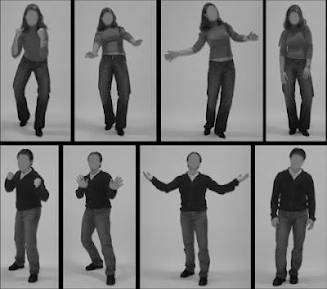 |
BEAST - The Bodily Expressive Action Stimulus Test (BEAST). Construction and Validation of a Stimulus Basis for Measuring Perception of Whole Body Expression of Emotions. |
The ‘Bodily Expressive Action Stimulus Test’ is een creatie en een stimulus basis om het waarnemen van uitdrukkingen van emoties in het lichaam te meten.
Om de waarneming van emotie te onderscheiden, worden visuele
gegevens verzameld en kunnen patronen in lichaamstaal worden gedetecteerd.
In de publicatie van Joseph Walls et al 'Pain communication through body posture' wordt pijn naast de gegeven basis emotie-uitdrukkingen onderzocht op het non-verbale via gezichtsuitdrukkingen, vocalisaties en lichaamstaal. Vooral de houding weergave kreeg aandacht en resulteerde in een nieuwe stimulusset van dynamische lichaamshoudingen die pijn en de 6 basisemoties communiceren.
Er waren 3 verschillende groepen deelnemers betrokken: 16 acteurs voerden affectieve lichaamshoudingen uit en 2 groepen waarnemers kozen onafhankelijk van elkaar de meest betrouwbare afbeeldingen. Een uiteindelijke set van 144 afbeeldingen met een goede betrouwbaarheid werd vastgesteld en beschikbaar gesteld (zie afbeelding.
De resultaten tonen aan dat pijn, samen met basisemoties, kan worden gecommuniceerd via lichaamshouding. Clusteranalyse toont aan dat pijn en emotie met een hoge mate van specificiteit worden herkend. Enkele kenmerken zoals genoemd in het onderzoek van Joseph Walls zijn:
- Kwaad Hoofd en blik voorwaarts gericht, hele lichaam leunt voorover, romp is naar voren gericht, linker- en rechterarmen voor, gebogen ellebogen, gebalde handen, linker- en rechterknie gebogen.
- Walging Hoofd afgewend, blik voorwaarts, romp afgewend, linker- en rechterarmen voor, handpalmen naar voren gericht, benen recht.
- Bang Hoofd naar voren gericht, blik naar beneden, lichaam buigt niet,
gewicht naar achter, de romp voorwaarts gericht, gebogen knieën en ellebogen, handpalmen naar voren gericht,
- Blij Hoofd naar voren gericht, blik naar boven, het lichaam rechtop, armen verticaal, ellebogen en knieën recht.
- Verdrietig Hoofd naar voren gericht, blik naar beneden, voorwaarts
lichaam leunt voorwaarts, linker- en rechterarmen zijwaarts, gebogen knieën
- Verwondering Hoofd naar voren gericht, blik voorwaarts,
Lichaam achterwaarts gebogen, romp afgewend, armen verticaal, ellebogen gebogen, knieën recht.
- Gericht in pijn Hoofd afgewend, blik naar beneden, lichaam voorovergebogen en romp voorwaarts, ellebogen gebogen, armen verticaal, handen manipuleren verwondingsplaats, knieën gebogen.
- Ongericht in pijn Hoofd en romp afgewend, linker- en rechterhanden raken verschillende plaatsen, knie gebogen, schouder naar voren.
‘Why bother about bodies?’: De wetenschap heeft dit gebied van lichaamstaal al te lang vermeden. Te complex? Beatrice de Gelder, neurowetenschapper, besprak in haar artikel 'Why bodies' het feit dat er eigenlijk geen historische verklaring is voor waarom er sinds Darwins onderzoek naar 'expressies van mens en dier' niet veel aandacht is besteed aan lichaamsuitdrukkingen.
In de afgelopen decennia heeft meer dan 95 procent van de sociale en affectieve neurowetenschappen gezichten als stimuli gebruikt.
Paul Ekman bestudeerde aan het begin van zijn onderzoek naar uitdrukkingen van emotie de herkenning van emotie uit lichaamsuitdrukkingen, maar legde dat terzijde, waarschijnlijk omdat de eerste resultaten te complex leken en de kans om bewijs te vinden dat uitdrukking van emotie universeel is, beter te doen was met gezichtsuitdrukkingen.
Nu is het duidelijk dat het lichaam net zo betrouwbaar is als het gezicht bij het uiten van emoties en moeten we de vanzelfsprekendheid herkennen dat het lichaam in zijn uitdrukking informatie, intenties en acties in zich draagt.
Strategie: Zoals dansers en vooral mimespelers al lang beseffen en weten, is lichaamstaal een overtuigend sprekend medium en heeft het lichaam een eigen stem. Subtekst, emoties, taboes, ongeschreven regels, worden allemaal bewust of onbewust gedeeld: het lichaam kan niet liegen!
Wanneer we met elkaar in contact komen, ontmoeten, praten, nemen we een positie in als mens tot mens, we veranderen van niveau en vlak in een constante stroom van houdingen in de ruimte.
Dat wil zeggen: We draaien, kantelen en verhogen dan wel verlagen onze houding ten opzichte van elkaar om zo continu na te gaan hoe de verhouding met de ander is en moet-kan veranderen. Dan speel je de boventoon, dan weer ben je de mindere.
In gesprek met woorden helpen de argumenten om je de meerdere te weten, het lichaam laat dit dan onmiddellijk zien met groeiend besef van gelijk bijvoorbeeld en vol trots zwelt de borstkas op en torent boven de ander in spanning en zelfbewust uit.
Elk moment wordt ons gedrag bepaald door ons af te meten om op zijn minst op hetzelfde niveau te komen als de ander. Deze strategie is van belang om te weten hoe we onze emotie moeten richten: moet ik bescheiden incasseren of voluit ertegen in gaan om zo een beter voordeel te halen op de lange termijn of zal ik de ander verwarren door met opportunistische vrolijkheid alle bezwaren naar de achtergrond te laten verdwijnen.
Elke emotie uitdrukking heeft een eigene duur en dynamiek:
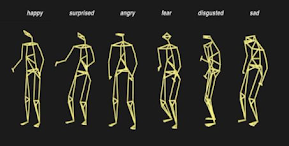
6 basis emotie uitdrukkingen in skelet-tekenfiguren via Qualisys Capture Motion
De tijdsduur en het ruimtegebruik van het lichaam maken een eigenheid in dynamiek bij de uitdrukking van emotie. Bij de vorming van de uitdrukking is de ruggengraat van groot belang. Opvallend is dat de armen en benen mee doen zodra de ruggengraat zich vormt. De ruimte varieert met elke uitdrukking, ‘blij’ gaat veel meer omhoog en naar voren, ‘verbaasd’ beweegt meer in de breedte en ‘kwaad’ staat stevig in het midden. In de bewerkte film bewegende beelden in een lus vooruit en achteruit, zodat je de beweging van begin tot eind en van eind tot begin kunt bestuderen:
‘Blij’ en ‘Verbaasd’ duren 6 sec,
‘Kwaad’ is het langst met 14 sec,
‘Bang’ en ‘Verdrietig’ duren 10-11 sec en
'Walgend' duurt 7 sec en na 33 sec eindigt de filmsequentie.
Niet alleen basisemotie-expressies hebben hun eigen 'melodie' maar ook alle andere universeel herkenbare expressies. Daarvan zijn er 6 basis emotie uitdrukkingen en 15 samengestelde emotie uitdrukkingen:
Blij | Verdrietig | Bang | Kwaad | Verwonderd | Walgend |
Blij verbaasd | Blij walgend | Verdrietig bang | Verdrietig kwaad | Verdrietig verwonderd | Verdrietig walgend |
Bang boos | Bang verwonderd | Bang walgend | Kwaad verwonderd | Kwaad walgend | Walgend verwonderd |
|
|
| Ontsteld, geschokt | Hatend | Verbouwereerd, vervuld van ontzag |
Natuurlijk zijn er meer dan 21, maar dan is de universele herkenbaarheid moeilijker:
te veel kenmerken van de betrokken expressies tegelijkertijd zullen elkaar tegenspreken of uitsluiten en dus moeilijker te herkennen zijn. In de videofilm werd het tekstonderwerp live opgenomen en vervolgens met Qualisys en software omgezet in een skeletstokfiguur.
Ik ben er van overtuigd dat elke uitdrukking van emotie zijn eigen speciale architectuur heeft:
Het Blij zijn heeft bijvoorbeeld een sterke opwaartse en voorwaartse vorm en de bewegende lichaamsdelen zullen waarschijnlijk (zoals een glimlach) omhoog neigen. De duur voor het vormen van de uitdrukking van emotie is kort.
Het Walgend kost veel meer tegenkracht en zal in het vormen van de houding langzaam verlopen en naar achteren toe wegdraaien om zoveel mogelijk afstand te krijgen van de bron.
‘De Dans van Emoties’:
https://youtu.be/WdEjXteiQTY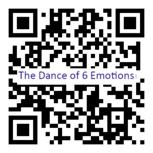 (\QR*nr)
(\QR*nr)
‘De Dans van Emoties’ combineert 4 studies van 6 emoties uitdrukkingen.
De liveopnamen zijn gemaakt met behulp van acteurs Nick, Gerben, Nina, Keedie.
Elk individu toont zijn eigen dynamiek in het uiten van een emotie.
Elke emotie uitdrukking heeft ook zijn eigen karakteristieken in dynamiek en ruimte en tijd.
De timing van elke uitdrukking wordt beïnvloed door iemands eigen persoonlijke motoriek. In de gecombineerde studies worden de emotie uitdrukkingen heen en weer gedraaid. De totale film duurt 33 seconden - bijvoorbeeld Nick toont zijn blije emotie in 6 seconden elk = 3 keer vooruit en bijna 3 keer achteruit in 33 seconden Timing van de daaropvolgende emotie uitdrukkingen:
Acteurs | Blij | Verwonderd | Kwaad | Bang | Walgend | Verdrietig |
Nick | 6 | 6 | 14 | 11 | 7 | 6 |
Gerben | 4 | 8 | 7 | 10 | 6 | 10 |
Nina | 4 | 6 | 8 | 7 | 8 | 10 |
Keedie | 5 | 9 | 12 | 10 | 10 | 12 |
Mijn observaties vanuit het raam: Om iemands emotie te onderscheiden ‘lezen’ we in een fractie van een seconde de individuele manier van lopen en houding van grote afstand. Bovendien kan men op datzelfde moment iemands individuele stemming herkennen.
Een theatermaker en mimespeler observeert. Op het marktplein bijvoorbeeld zie ik automatisch een hele mimografie (compositie mime) van beweging en mensen die elk op hun eigen manier voorbij lopen en rennen.
Toen ik me realiseerde dat ik gefascineerd ben door de ruggengraat en de uitdrukkingen van emotie in het lichaam, vond ik een goed voorbeeld dat de essentie gemakkelijk uitlegt:
Je staat 's avonds voor het raam en je kijkt, zoals gewoonlijk na een hele dag werken,
uit het raam naar de overkant van de straat waar je iemand op de stoep ziet lopen. Het is donker, je ziet geen gezicht. Er zijn ook geen opvallende kenmerken in kleding of anderszins die herkenning makkelijk maken. Je kent haar niet, niet echt, hoewel het ergens een belletje doet rinkelen. Je kijkt gewoon naar de persoon die voorbij loopt zonder direct geïnteresseerd te zijn in de gebeurtenis.
Je kijkt en denkt er niet dieper over na en de persoon in kwestie loopt op ongeveer 50 meter afstand over het trottoir. Je realiseert je ineens dat je haar kent: het moet die verre buurvrouw zijn, die je maanden geleden eens begroette bij een gelegenheid, omdat je dacht haar te kennen.
Op hetzelfde moment besef je ook, dat er iets meer aan de hand is, zij lijkt depressief en verdrietig. Hoe merk je dat allemaal op, in zo'n korte tijd?
De manier van bewegen is voor ieder individu heel uniek, we begrijpen het direct en zonder vooringenomenheid.
De kenmerken zijn onder andere een bepaald ritme, de volgorde van beweging, een specifieke intensiteit en dynamiek, die allemaal alleen bij die specifieke persoon passen of onderdeel van de motoriek zijn geworden. Het is de manier waarop we elkaar kunnen herkennen, en het is de manier waarop we onszelf als individu definiëren en uiten.
De, op dat moment overheersende, 'verdrietige en depressieve' emotie of stemming uit zich in de karaktertrekken van de manier van lopen en bewegen. Het kan iets doen met de timing, ademhaling, het kan de houding en gewichtsverplaatsing veranderen, maar het verandert niet de gegeven karakteristieken in een andere persoonlijkheid of motoriek.
Van de publicatie op 7 maart 2025 heb ik een samenvatting gemaakt: het verhaal laat zien hoe de eigene motoriek als vaststaand en herkenbaar kan worden beschouwd:
‘Loopanalyse – Deze wetenschappers kunnen verdachten herkennen aan hun loopje.’ ‘Een looppatroon is niet zo uniek als DNA maar kan toch in de rechtszaal worden gebruikt. Met een masker kun je je gezicht bedekken en handschoenen voorkomen vingerafdrukken, maar je eigen manier van lopen kun je moeilijk verbloemen. (artikel van Elleke Bal in Trouw 7-3-2025).
De dader van een brutale overval op een Groningse Albert Heijn werd in 1e instantie vrijgesproken. Met een masker op was hij de supermarkt ingelopen, bedreigde een medewerker en ging er met de buit vandoor. De overvaller had op camerabeelden een kenmerkend loopje.
Bij de afdeling Bewegingswetenschappen van de Rijksuniversiteit Groningen kwam in 2016 de vraag voor hulp. Hoogleraar neuromechanica Bert Otten ging daarop aan het werk.
Het analyseren van bewegingen is zijn vak. Hij bouwde al een carrière lang software voor 3d modellen van menselijke bewegingen. Die gebruikte hij bijvoorbeeld om sporters te helpen en voor revalidatieprogramma’s of prothesen.
Met Mickey Wiedemeijer samen bedacht hij een manier om looppatronen in kaart te brengen. Mede op basis van hun bewijs werd de verdachte uiteindelijk toch veroordeeld.
Negen jaar later heeft de loopjes analyse al in 70 zaken een rol gespeeld.
In de analyse wordt gelet op kenmerken zoals de stand van de voet, de draaiing van de romp en de positie van het hoofd. Bij de analyse speelt ook een statistische kans op overeenkomst tussen dader en verdachte op basis van de zogeheten Bayesiaanse statistiek, een kansberekening die in de forensische wetenschap de norm is.’



